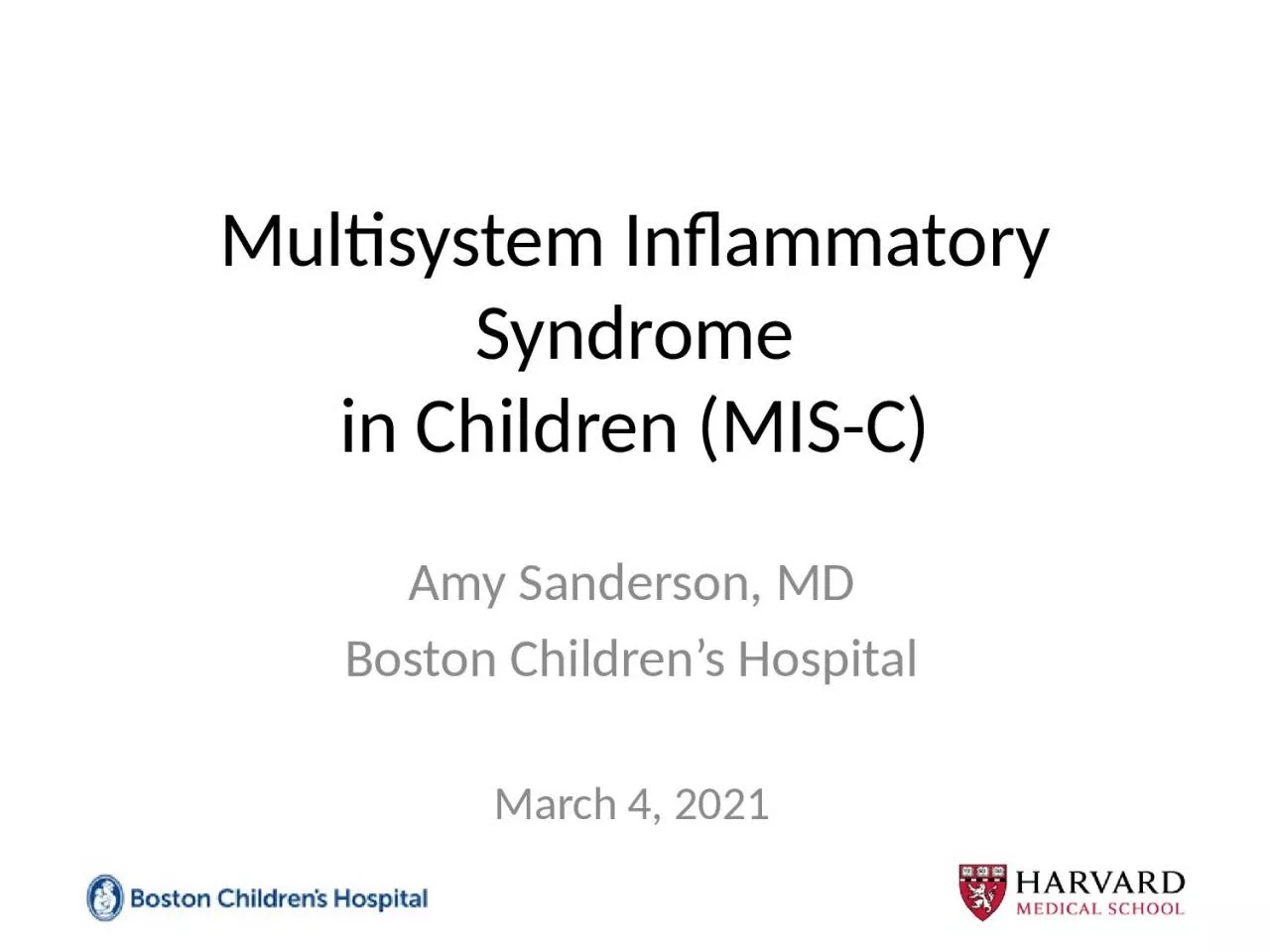

in Children MISC Amy Sanderson MD Boston Childrens Hospital March 4 2021 Vari Progress in Pediatric Cardiology Volume 58 2020 Case study 14year old multiracial Caucasian and Hispanic ID: 1014773
Download Presentation The PPT/PDF document "Multisystem Inflammatory Syndrome" is the property of its rightful owner. Permission is granted to download and print the materials on this web site for personal, non-commercial use only, and to display it on your personal computer provided you do not modify the materials and that you retain all copyright notices contained in the materials. By downloading content from our website, you accept the terms of this agreement.
1. Multisystem Inflammatory Syndromein Children (MIS-C)Amy Sanderson, MDBoston Children’s HospitalMarch 4, 2021
2. Vari. Progress in Pediatric Cardiology, Volume 58, 2020
3. Case study14-year old multiracial (Caucasian and Hispanic) male; PMH: constipation & eczema Presented to the ED with 4 days of fever, fatigue, & abdominal pain (in stable condition without significant multisystem involvement)During hospitalization, he developed severe LV dysfunction and mixed hypovolemic, distributive and cardiogenic shockDischarged home after 12 daysF/U echo normalVari. Progress in Pediatric Cardiology, Volume 58, 2020
4. CDC Case Definition An individual aged <21 years presenting with fever, laboratory evidence of inflammation and evidence of clinically severe illness requiring hospitalization, with multisystem (>2) organ involvement; ANDNo alternative plausible diagnoses; ANDPositive for current or recent SARS-CoV-2 infection by RT-PCR, serology, or antigen test; or exposure to a suspected or confirmed COVID-19 case within the 4 weeks prior to the onset of symptomswww.cdc.gov/mis-c/hcp
5. Incidence It’s rare!Dufort EM. N Engl J Med. 2020;383(4):347
6. Pathophysiology
7. Presenting symptomsPersistent fevers (median duration 4 to 6 days) 100%Gastrointestinal symptoms (abd pain, N/V, diarrhea) 60-100%Rash 45-76%Conjunctivitis 30-81%Mucous membrane involvement 27-76%Neurocognitive symptoms (headache, lethargy, confusion) 29-58%www.uptodate.com
8. Presenting symptomsRespiratory symptoms (tachypnea, dyspnea) 21-65%Sore throat10-16% Myalgias8-17%Swollen hands/feet 9-16%Lymphadenopathy6-16%www.uptodate.com
9. Clinical FindingsShock 32-76%Criteria for complete Kawasaki disease met 22-64%Myocardial dysfunction (by echo or elevated troponin/BNP) 51-90%Arrhythmia12%Acute respiratory failure requiring noninvasive or invasive ventilation 28-52%Acute kidney injury 8-52%Serositis (small pleural, pericardial, and ascites) 24-57%Hepatitis or hepatomegaly 5-21%Encephalopathy, seizures, coma, or meningoencephalitis 6-7%www.uptodate.com
10. Laboratory findingswww.uptodate.comLymphocytopenia 80-95%Neutrophilia 68-90%Mild anemia 70%Thrombocytopenia 31-80%Hypoalbuminemia 48-95%Mildly elevated liver enzymes 62-70%Elevated lactate dehydrogenase 10-60%Hypertriglyceridemia 70%
11. Laboratory findingswww.uptodate.comC-reactive protein 90-100%Erythrocyte sedimentation rate 75-80%D-dimer 67-100%Fibrinogen 80-100%Ferritin 55-76%Procalcitonin 80-95%Interleukin-6 80-100%Troponin 50-90%BNP or NT-pro-BNP 73-90%
12. Imaging findingswww.uptodate.comEchocardiogram Depressed LV function 31-58%Coronary artery dilation/aneurysm 8-38%Other findings can include mitral regurgitation and pericardial effusion --Chest radiograph Normal in many patients --Abnormal findings included small pleural effusions, patchy consolidations, focal consolidation, and atelectasis --
13. Imaging findingswww.uptodate.comChest CT Findings generally similar to those on chest radiograph A few patients had nodular ground-glass opacification Abdominal imaging (ultrasound and/or CT) Findings are nonspecific, including free fluid, ascites, bowel and mesenteric inflammation, including terminal ileitis, mesenteric adenopathy/adenitis, and pericholecystic edema
14. Clinical spectrumwww.uptodate.com
15. COVID-19 or MIS-C?COVID-19Median age 11.7 yearsMore likely to be Hispanic or LatinoMore likely to have ≥ 1 chronic medical conditions 57% had GI symptomsHigher platelet countMIS-CMedian age 8.9 yearsMore likely to be non-Hispanic BlackMore likely to have mucocutaneous findings90% had GI symptomsMore likely to have cardiac involvement Feldstein LR. JAMA. February 24, 2021
16. Kawasaki Disease or MIS-C?Kawasaki DiseaseInfants and young childrenHigher incidence in East Asia and in pts of Asian descentAbsolute lymphocyte and platelet counts tend to be higherInflammatory markers tend to be less elevated MIS-COlder children & adolescentsBlack & Hispanic children disproportionally affectedGI symptoms (abdominal pain) are very common Myocardial dysfunction and shock occur more commonly
17. CodesMIS-C due to Covid-19 (current infection) U07.1 COVID-19 (principal diagnosis) M35.8 Other specified systemic involvement of connective tissue (secondary diagnosis) MIS-C due to previous Covid-19 infection (resolved)M35.8 Other specified systemic involvement of connective tissue (principal diagnosis) for the MIS-C B94.8 Sequelae of other specified infectious and parasitic diseases (secondary diagnosis) for the sequelae of a COVID-19 infection
18. Management based on presentation
19.
20. Other therapiesInterleukin-1 inhibitorsAnakinraCanakinumabIL-6 inhibitorsTocilizumabConvalescent plasmaAntithrombotic therapy
21. OutcomePrognosis is uncertain!Most children surviveMost with cardiac involvement recover functionNature & frequency of long-term complications are unknown
22. Thank you!Questions??amy.sanderson@childrens.harvard.edu